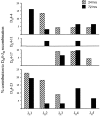Localized gene-specific induction of accessibility to V(D)J recombination induced by E2A and early B cell factor in nonlymphoid cells
- PMID: 11535632
- PMCID: PMC2195934
- DOI: 10.1084/jem.194.5.645
Localized gene-specific induction of accessibility to V(D)J recombination induced by E2A and early B cell factor in nonlymphoid cells
Abstract
Accessibility of immunoglobulin (Ig) gene segments to V(D)J recombination is highly regulated and is normally only achieved in B cell precursors. We previously showed that ectopic expression of E2A or early B cell factor (EBF) with recombination activating gene (RAG) induces rearrangement of IgH and IgL genes in nonlymphoid cells. VkappaI genes throughout the locus were induced to rearrange after transfection with E2A, suggesting that the entire Vkappa locus was accessible. However, here we show that Ig loci are not opened globally but that recombination is localized. Gene families are interspersed in the D(H), Vkappa, and Vlambda loci, and we show that certain families and individual genes undergo high levels of recombination after ectopic expression of E2A or EBF, while other families within the same locus are not induced to rearrange. Furthermore, in some families, induction of germline transcription correlates with the level of induced recombination, while in others there is no correlation, suggesting that recombination is not simply initiated by induction of germline transcription. The induced repertoire seen at 24 hours does not change significantly over time indicating the absence of many secondary rearrangements and also suggesting a direct targeting mechanism. We propose that accessibility occurs in a local manner, and that binding sites for factors facilitating accessibility are therefore likely to be associated with individual gene segments.
Figures







Similar articles
-
E2A and EBF act in synergy with the V(D)J recombinase to generate a diverse immunoglobulin repertoire in nonlymphoid cells.Mol Cell. 2000 Feb;5(2):343-53. doi: 10.1016/s1097-2765(00)80429-3. Mol Cell. 2000. PMID: 10882075
-
Basic helix-loop-helix proteins E2A and HEB induce immature T-cell receptor rearrangements in nonlymphoid cells.Blood. 2001 Oct 15;98(8):2456-65. doi: 10.1182/blood.v98.8.2456. Blood. 2001. PMID: 11588043
-
High frequency of matrix attachment regions and cut-like protein x/CCAAT-displacement protein and B cell regulator of IgH transcription binding sites flanking Ig V region genes.J Immunol. 2002 Sep 1;169(5):2477-87. doi: 10.4049/jimmunol.169.5.2477. J Immunol. 2002. PMID: 12193717
-
RAG1 and RAG2 in V(D)J recombination and transposition.Immunol Res. 2001;23(1):23-39. doi: 10.1385/IR:23:1:23. Immunol Res. 2001. PMID: 11417858 Review.
-
Dynamic Control of Long-Range Genomic Interactions at the Immunoglobulin κ Light-Chain Locus.Adv Immunol. 2015;128:183-271. doi: 10.1016/bs.ai.2015.07.004. Epub 2015 Aug 14. Adv Immunol. 2015. PMID: 26477368 Review.
Cited by
-
E2A and IRF-4/Pip promote chromatin modification and transcription of the immunoglobulin kappa locus in pre-B cells.Mol Cell Biol. 2006 Feb;26(3):810-21. doi: 10.1128/MCB.26.3.810-821.2006. Mol Cell Biol. 2006. PMID: 16428437 Free PMC article.
-
Assembly and analysis of the mouse immunoglobulin kappa gene sequence.Immunogenetics. 2004 Oct;56(7):490-505. doi: 10.1007/s00251-004-0659-0. Epub 2004 Sep 18. Immunogenetics. 2004. PMID: 15378297
-
E and ID proteins branch out.Nat Rev Immunol. 2009 Mar;9(3):175-84. doi: 10.1038/nri2507. Nat Rev Immunol. 2009. PMID: 19240756 Review.
-
Cutting Edge: Proper Orientation of CTCF Sites in Cer Is Required for Normal Jκ-Distal and Jκ-Proximal Vκ Gene Usage.J Immunol. 2018 Sep 15;201(6):1633-1638. doi: 10.4049/jimmunol.1800785. Epub 2018 Aug 3. J Immunol. 2018. PMID: 30076197 Free PMC article.
-
Id1 has a physiological role in regulating early B lymphopoiesis.Cell Mol Immunol. 2011 Jan;8(1):41-9. doi: 10.1038/cmi.2010.58. Epub 2010 Dec 6. Cell Mol Immunol. 2011. PMID: 21200383 Free PMC article.
References
-
- Yancopoulos G.D., Alt F.W. Regulation of the assembly and expression of variable-region genes. Annu. Rev. Immunol. 1986;4:339–368. - PubMed
-
- Sleckman B.P., Gorman J.R., Alt F.W. Accessibility control of antigen-receptor variable-region gene assemblyrole of cis-acting elements. Annu. Rev. Immunol. 1996;14:459–481. - PubMed
-
- Sleckman B.P., Bassing C.H., Bardon C.G., Okada A., Khor B., Bories J.C., Monroe R., Alt F.W. Accessibility control of variable region gene assembly during T-cell development. Immunol. Rev. 1998;165:121–130. - PubMed
-
- Havran W.L., Allison J.P. Developmentally ordered appearance of thymocytes expressing different T-cell antigen receptors. Nature. 1988;335:443–445. - PubMed

